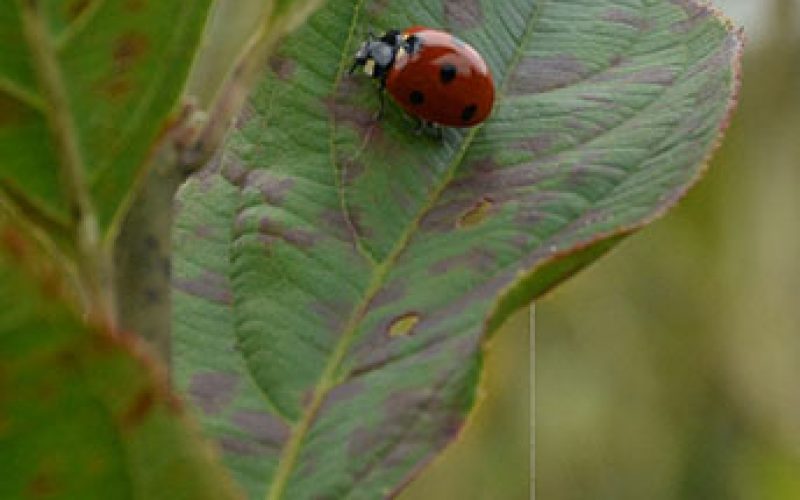They’re beautiful, strange and sometimes sting!
AMANDA BANCROFT
Making Ripples
Gardens are like neighborhoods in miniature, with itty bitty insects of all sorts crawling, fluttering and hopping around the mulch roads and stem skyscrapers. But in this neighborhood, who’d play Mr. Rogers? They’re all too busy eating each other — Rogers was a vegetarian — or chomping down their own plant house as though it were made of gingerbread. Predators do like their prey “just the way they are” and certainly want to live in the neighborhood with them — with the exception of certain caterpillars, which we will introduce in a moment.

A praying mantis pauses in the middle of its yoga-like routine on a sweetspire plant.
(Courtesy Photo/Amanda Bancroft)
There are plenty of predators in this neighborhood. Have you ever seen a native brown praying mantis hang upside down and paw the air like a kitten on its back toying with a ball of yarn? Well, they do. “Our” mantis was in the middle of this yoga-like routine, and I couldn’t figure out what it was reaching for; there was nothing close enough to grab! Then, still upside down, it quickly leaped onto the underside of a distant leaf. It was astonishing acrobatics for a creature that looks as nimble as a dry twig.
Our greywater garden has only two swamp milkweed plants that send up about a dozen shoots resembling bamboo. Ants love to farm aphids on these stalks, and predatory ladybugs consider this their fast food drive-through. Four sweetspire bushes surround the milkweed, so that Monarch butterflies have a one-stop shop: nectar, breeding habitat, caterpillar food and branches to hang a chrysalis.
There were over 27 Monarch caterpillars ready to build their gold-jeweled chrysalises, which now decorate our bushes one per every foot or so. These little green ornaments hang from the branches, making it feel like Christmas already. The white, black and yellow striped “candy canes” among the ornaments are the monarch caterpillars themselves, which hang upside down in a “J” shape before the chrysalis forms. But hardly anyone wants to eat them! They’re poisonous.
You may already be familiar with the venomous stinging rose moth caterpillar after my encounter with Spikey Banana a few weeks ago. There are other local caterpillar residents to watch out for, too, and these are more common. If it looks like a bald fairy lost its tiny toupee on a leaf, do not attempt to return it to them! These orange, white or brown flannel moth caterpillars are covered in soft hairs that hide sharp venomous spikes. Local natives include the White Flannel Moth Caterpillar (Norape ovina) and the Black-Wave Flannel Moth Caterpillar (Megalopyge crispata).

A Monarch caterpillar hangs upside down in a “J” shape before the chrysalis forms. But hardly anyone wants to eat them! They’re poisonous.
(Courtesy Photo/Amanda Bancroft)
Fortunately, most dangerous caterpillars have bright aposematic coloration. The Saddleback Caterpillar (Acharia stimulea) looks like a horse that nobody wants to ride, with visible spikes surrounding its painted green saddle. Its venom is among the most painful of North American caterpillars. Spiny Oak Slugs (Euclea delphinii) have the decency to ward us off with their fluorescent green, orange, red and yellow patterns of spikes. The Buck Moth (Hemileuca maia) makes a less flamboyant appearance as a goth caterpillar covered in black thorns. Io Moth caterpillars (Automeris io) show off their green forest of spikes with red and white stripes down their sides. Definitely social distance from these critters!
I don’t know which of my tiny neighbors would play the role of Mr. Rogers in their garden neighborhood. But it wouldn’t be caterpillars, that’s for sure!
Amanda Bancroft is a writer, artist, and naturalist living in an off-grid tiny house on Kessler Mountain. She and her husband Ryan blog about their adventures and offer tips to those wanting to make a difference at www.RipplesBlog.org.











